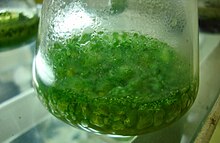
Back জীৱাণুসাৰ Assamese Biofertilitzant Catalan Biogødning Danish Biodünger German Bioväetis Estonian کود زیستی Persian Biofertilisant French जैव उर्वरक (बायोफर्टिलाइजर) Hindi Pupuk mikrobiologis ID Mkpụrụ osisi na-eme ka ihe ndị dị ndụ IG

A biofertilizer is a substance which contains living micro-organisms which, when applied to seeds, plant surfaces, or soil, colonize the rhizosphere or the interior of the plant and promotes growth by increasing the supply or availability of primary nutrients to the host plant.[1] Biofertilizers add nutrients through the natural processes of nitrogen fixation, solubilizing phosphorus, and stimulating plant growth through the synthesis of growth-promoting substances. The micro-organisms in biofertilizers restore the soil's natural nutrient cycle and build soil organic matter. Through the use of biofertilizers, healthy plants can be grown, while enhancing the sustainability and the health of the soil. Biofertilizers can be expected to reduce the use of synthetic fertilizers and pesticides, but they are not yet able to replace their use. Since they play several roles, a preferred scientific term for such beneficial bacteria is "plant-growth promoting rhizobacteria" (PGPR).
- ^ Vessey, J. Kevin (2003). "Plant growth promoting rhizobacteria as biofertilizers". Plant and Soil. 255 (2): 571–586. doi:10.1023/A:1026037216893. S2CID 37031212.
© MMXXIII Rich X Search. We shall prevail. All rights reserved. Rich X Search